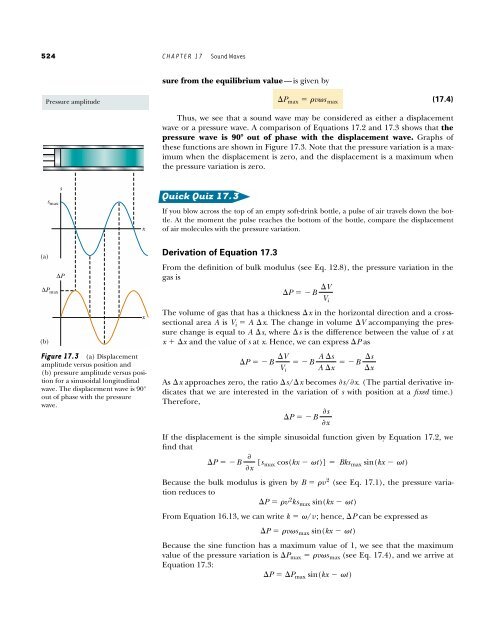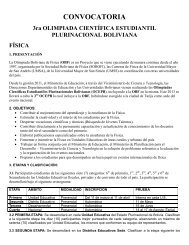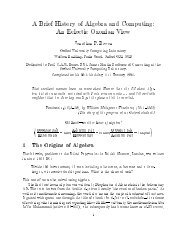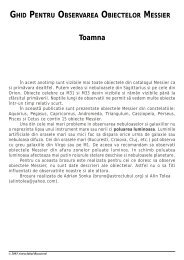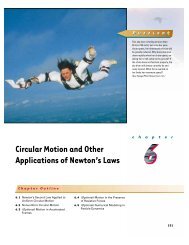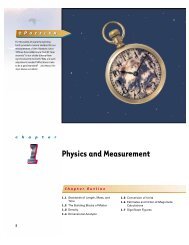Create successful ePaper yourself
Turn your PDF publications into a flip-book with our unique Google optimized e-Paper software.
524 CHAPTER 17 <strong>Sound</strong> <strong>Waves</strong><br />
(a)<br />
(b)<br />
Pressure amplitude<br />
s max<br />
∆P max<br />
s<br />
∆P<br />
Figure 17.3 (a) Displacement<br />
amplitude versus position and<br />
(b) pressure amplitude versus position<br />
for a sinusoidal longitudinal<br />
wave. The displacement wave is 90°<br />
out <strong>of</strong> phase with the pressure<br />
wave.<br />
x<br />
x<br />
sure from the equilibrium value—is given by<br />
(17.4)<br />
Thus, we see that a sound wave may be considered as either a displacement<br />
wave or a pressure wave. A comparison <strong>of</strong> Equations 17.2 and 17.3 shows that the<br />
pressure wave is 90°out <strong>of</strong> phase with the displacement wave. Graphs <strong>of</strong><br />
these functions are shown in Figure 17.3. Note that the pressure variation is a maximum<br />
when the displacement is zero, and the displacement is a maximum when<br />
the pressure variation is zero.<br />
Quick Quiz 17.3<br />
If you blow across the top <strong>of</strong> an empty s<strong>of</strong>t-drink bottle, a pulse <strong>of</strong> air travels down the bottle.<br />
At the moment the pulse reaches the bottom <strong>of</strong> the bottle, compare the displacement<br />
<strong>of</strong> air molecules with the pressure variation.<br />
Derivation <strong>of</strong> Equation 17.3<br />
From the definition <strong>of</strong> bulk modulus (see Eq. 12.8), the pressure variation in the<br />
gas is<br />
�P ��B �V<br />
Vi The volume <strong>of</strong> gas that has a thickness �x in the horizontal direction and a crosssectional<br />
area A is Vi � A �x. The change in volume �V accompanying the pressure<br />
change is equal to A �s, where �s is the difference between the value <strong>of</strong> s at<br />
x ��x and the value <strong>of</strong> s at x. Hence, we can express �P as<br />
�P ��B �V<br />
V i<br />
�P max � �v�s max<br />
��B<br />
A �s<br />
A �x<br />
As �x approaches zero, the ratio �s/�x becomes (The partial derivative indicates<br />
that we are interested in the variation <strong>of</strong> s with position at a fixed time.)<br />
Therefore,<br />
�P ��B �s<br />
�s/�x.<br />
�x<br />
If the displacement is the simple sinusoidal function given by Equation 17.2, we<br />
find that<br />
�P ��B �<br />
�x [smax cos(kx � �t)] � Bksmax sin(kx � �t)<br />
Because the bulk modulus is given by (see Eq. 17.1), the pressure variation<br />
reduces to<br />
�P � �v<br />
From Equation 16.13, we can write k � �/v ; hence, �P can be expressed as<br />
2 B � �v<br />
ksmax sin(kx � �t)<br />
2<br />
�P � �v�s max sin(kx � �t)<br />
��B �s<br />
�x<br />
Because the sine function has a maximum value <strong>of</strong> 1, we see that the maximum<br />
value <strong>of</strong> the pressure variation is �Pmax � �v�smax (see Eq. 17.4), and we arrive at<br />
Equation 17.3:<br />
�P ��Pmax sin(kx � �t)


